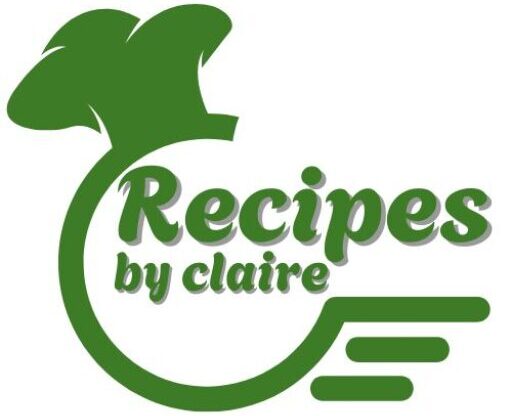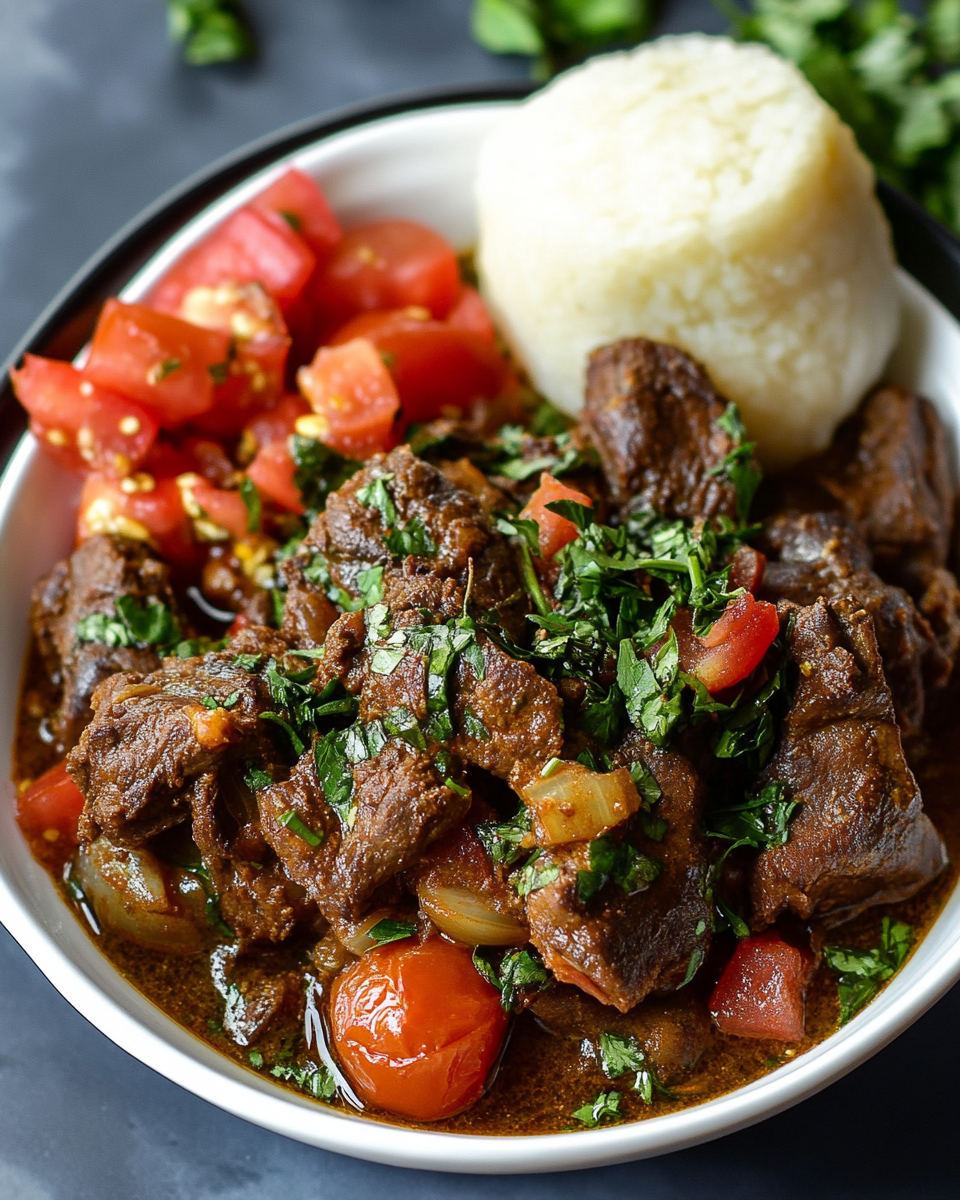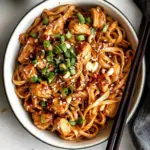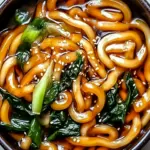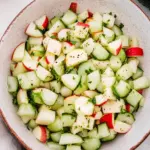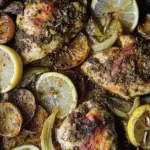The Kenyan Goat Wet Fry is a rustic and flavorful dish that showcases the richness of East African cuisine. The goat meat is slow-cooked until tender, then seared in spices and tomatoes to lock in flavor. Paired with sukuma wiki, a vibrant sautéed collard green dish, and the refreshing crunch of kachumbari salad, this is a complete sensory experience. No Kenyan meal is complete without ugali a firm, maize-based staple that perfectly balances the boldness of the other components. This combination brings together textures, spice, and freshness in every bite, representing not just food, but culture and tradition. It’s a meal to savor, enjoy with company, and return to time and time again.
Full Recipe:
Ingredients:
For the Goat Wet Fry:
-
2 lbs goat meat, bone-in, cut into chunks
-
1 large onion, finely chopped
-
2 tomatoes, diced
-
2 tbsp ginger-garlic paste
-
2 green chilies, sliced
-
1 tsp black pepper
-
1 tsp ground cumin
-
1 tsp paprika
-
1 tsp salt (or to taste)
-
2 tbsp vegetable oil
-
Fresh coriander leaves for garnish
For Sukuma Wiki (Collard Greens):
-
1 bunch sukuma wiki (collard greens), chopped
-
1 medium onion, sliced
-
1 tomato, diced
-
1 tbsp vegetable oil
-
Salt to taste
For Kachumbari (Fresh Tomato & Onion Salad):
-
2 tomatoes, diced
-
1 red onion, thinly sliced
-
1 small bunch cilantro, chopped
-
Juice of 1 lime
-
Salt to taste
For Ugali (Maize Flour Cake):
-
2 cups maize flour (cornmeal)
-
4 cups water
Directions:
Goat Wet Fry:
-
Place goat meat in a pot and boil with minimal water until tender (about 40 minutes). Drain any excess water.
-
In a large pan, heat oil and sauté onions until golden.
-
Add ginger-garlic paste, green chilies, and tomatoes. Cook until tomatoes are soft.
-
Add boiled goat meat and all spices. Fry while stirring continuously for about 15–20 minutes until meat browns and oil separates.
-
Garnish with coriander leaves and set aside.
Sukuma Wiki:
-
Heat oil in a pan, sauté onions until translucent.
-
Add tomatoes and cook until soft.
-
Add chopped sukuma wiki and sauté for 5–7 minutes until tender but still green. Add salt to taste.
Kachumbari:
-
Mix diced tomatoes, onions, and cilantro in a bowl.
-
Add lime juice and salt. Toss and refrigerate until ready to serve.
Ugali:
-
Bring water to a boil in a large saucepan.
-
Gradually add maize flour while stirring continuously.
-
Keep stirring and cooking until it forms a dense, dough-like consistency.
-
Cover, let steam for a few minutes, then shape into a mound and serve.
Prep Time: 20 minutes | Cooking Time: 1 hour | Total Time: 1 hour 20 minutes
Kcal: 620 kcal | Servings: 4 servings
A Culinary Celebration: Kenyan Goat Wet Fry with Sukuma Wiki, Kachumbari, and Ugali
East African cuisine is an extraordinary tapestry of flavors, deeply rooted in tradition and community. One dish that truly embodies this spirit is the Kenyan Goat Wet Fry, often served with Sukuma Wiki (collard greens), Kachumbari (fresh tomato and onion salad), and the ever-present Ugali (maize flour cake). This hearty meal brings together texture, spice, and freshness in a way that speaks to both rural traditions and urban kitchens across Kenya.
Whether you’re exploring African cooking for the first time or are looking to bring the taste of home into your kitchen, this dish offers both familiarity and cultural richness. Let’s delve deeper into each component, its cultural relevance, nutritional insights, and tips to perfect this dish in your home kitchen.
The Heart of the Dish: Goat Wet Fry (Nyama Fry)
“Nyama Fry,” as it’s commonly called, is a cherished dish in Kenyan households, eateries, and roadside joints. “Wet Fry” distinguishes it from “dry fry,” which contains less gravy and is more about browning the meat until crisp. In the wet fry version, goat meat is simmered until tender, then fried in oil with onions, tomatoes, garlic, ginger, chilies, and aromatic spices. The outcome is rich, meaty, and incredibly flavorful.
Goat meat is a favorite protein in Kenyan cuisine. It’s leaner than beef, more flavorful than chicken, and holds up beautifully to slow cooking and frying. In many communities, especially during celebrations, goat meat is the centerpiece of feasts roasted, stewed, or fried. The wet fry method preserves moisture while giving it a caramelized, slightly spicy edge.
What truly sets this dish apart is the layering of ingredients. The onions are fried until golden, the tomatoes broken down into a thick base, and the spices not just added, but cooked out until aromatic. This technique adds depth and ensures that the goat meat absorbs every bit of flavor.
A Balanced Plate: The Accompaniments
Sukuma Wiki – Kenya’s Beloved Greens
“Sukuma Wiki” literally translates to “stretch the week” in Swahili, which reflects its status as a budget-friendly and nutritious staple. It’s made by sautéing finely chopped collard greens with onions and tomatoes, seasoned with a touch of salt.
Simple, but never dull, sukuma wiki provides a mild, earthy contrast to the boldness of goat wet fry. It’s also packed with vitamins A, C, and K, plus calcium and fiber. As a green vegetable, it adds balance and nutrition to a meat-heavy meal, offering both digestive support and color to the plate.
Kachumbari – A Fresh Flavor Punch
Think of kachumbari as Kenya’s answer to salsa or pico de gallo. Made with raw diced tomatoes, red onions, chopped coriander (cilantro), and a squeeze of lime or lemon juice, it delivers brightness and crunch. It’s an essential palate cleanser on the plate, cutting through the rich fat of the goat meat.
Some versions include chili, avocado, or cucumber, but the classic recipe remains refreshingly simple. Kachumbari doesn’t require cooking, making it a quick and healthy side dish that elevates any traditional meal.
Ugali – The Staple That Grounds the Meal
No Kenyan meal is complete without ugali, the doughy, polenta-like starch made from maize flour (cornmeal) and water. Ugali is neutral in flavor, but its dense texture makes it perfect for scooping up stews and sautéed greens with your hands a common and celebrated practice across East Africa.
Ugali is more than a side; it’s the cultural glue of the meal. It’s filling, affordable, and often the first thing cooked in every Kenyan household. Though simple to make, mastering its texture firm, yet pliable is an art.
Cultural Significance
Kenyan meals are typically communal, and goat meat is often reserved for special occasions like weddings, dowry negotiations, or festive holidays. Cooking goat wet fry can be a social activity, with friends and family gathering around to help prepare ingredients, stir the pot, or simply share stories while the meat simmers.
Each part of this meal represents a pillar of Kenyan food philosophy: meat for celebration, greens for health and balance, fresh produce for brightness, and a starch for satiety. This composition isn’t just about nutrition; it’s about identity, belonging, and tradition passed through generations.
Tips for Making It Perfect
1. Use Bone-In Goat Meat: Bones add depth and richness to the flavor as they simmer. Ask your butcher to cut the pieces medium-sized for even cooking.
2. Don’t Skip the Boil: Pre-boiling goat meat ensures tenderness. The frying stage then adds a final layer of flavor and texture.
3. Let It Brown: Give the meat time to sear and slightly caramelize during the frying step. It enhances the depth of flavor and adds slight crispiness.
4. Customize the Heat: Adjust the number of chilies depending on your spice tolerance. Kenyan households tend to enjoy it hot, but the balance is up to you.
5. Fresh is Best: Use ripe tomatoes and fresh greens. Since this meal relies on whole ingredients, their quality matters.
Nutrition Highlights
-
High in protein: Goat meat is an excellent source of lean protein and has fewer calories than beef.
-
Low in fat: Despite its richness, the dish is not greasy and is ideal for people seeking balanced meals.
-
Vitamin-rich: Sukuma wiki contributes essential nutrients including vitamin K, folate, and calcium.
-
Digestive aid: Kachumbari, being raw and acidic, helps stimulate digestion and adds hydration.
-
Energy dense: Ugali provides complex carbohydrates for sustained energy.
This makes the dish an ideal candidate for both celebratory meals and weekly comfort food, satisfying without compromising health.
Variations & Regional Twists
Though the core of this meal remains constant across Kenya, you may find regional variations:
-
In coastal areas, you might find coconut milk added to sukuma wiki for a creamy twist.
-
Some urban eateries add garam masala or coriander seeds to the goat wet fry for added aroma.
-
Substituting beef or lamb in place of goat is common if goat is unavailable.
-
Add avocado slices to the kachumbari for extra richness.
-
You may also find variations of ugali made from sorghum, millet, or cassava, especially in Western Kenya.
Serving Suggestions
This dish is traditionally served family-style on a large platter or in individual portions with all elements side by side. Use clean hands to eat, preferably the right hand, forming a scoop of ugali to pick up meat and vegetables. No cutlery needed just a strong appetite and good company.
To make it a complete meal experience:
-
Pair with a cold glass of Tusker beer or fresh mango juice
-
Serve on rustic earthenware for authenticity
-
Garnish with fresh coriander for extra aroma and visual appeal
Conclusion:
The Kenyan Goat Wet Fry with Sukuma Wiki, Kachumbari, and Ugali is more than just a recipe it’s a journey into Kenyan heritage. It brings together savory, spicy, fresh, and starchy elements in a balanced and nourishing way. Rooted in tradition, this dish has withstood the test of time, not just because it’s delicious, but because it brings people together. It’s comforting, it’s celebratory, and above all, it’s deeply satisfying.
Whether you’re preparing this meal for a family gathering, introducing friends to Kenyan food, or simply cooking for yourself, you’ll be tapping into the rich flavors and warm culture of East Africa. And once you’ve tasted it, there’s no going back this meal becomes a staple, a memory, and a story worth sharing.
